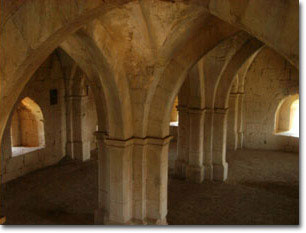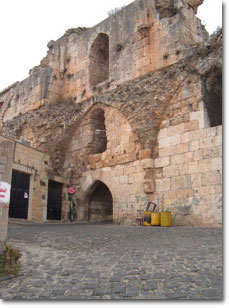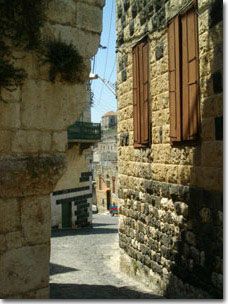|
 30 km from Tartous; Safita is one of the most picturesque towns in
Syria, set in beautiful orchard and olive-growing country dotted with
historic sites. It is equally accessible from Tartous. The Krak and
Drekish and the surrounding valleys contain many picnic spots, idyllic
particularly during the spring when the countryside is covered in
wildflowers. 30 km from Tartous; Safita is one of the most picturesque towns in
Syria, set in beautiful orchard and olive-growing country dotted with
historic sites. It is equally accessible from Tartous. The Krak and
Drekish and the surrounding valleys contain many picnic spots, idyllic
particularly during the spring when the countryside is covered in
wildflowers.
The area fell early into Crusader hands and is mentioned in Arab
sources as part of the domains of the Count of Tripoli fro 1112. The
building of the first castle probably dates from that time. In 1167 –
1171, Nūr al-Din took advantage of Crusader unprepared ness, occupying
Tartous, destroying Areimeh and largely demolishing the first version
of the Safita fortress, partly out of anger at Crusader piracy against
Egyptian merchant ships. The
castle fell into Muslim hands with barely a fight in February 1271,
taken by the Mameluke Sultan Baybars en route to the Krak. Though the town was almost totally Greek Orthodox Christian in the late
19th century, the Christian community had only begun to settle there
from the Hauran early in the previous century, gradually displacing the
Alawi inhabitants. Today the population is again mixed. Castle Blanc: Castle Blanc (called by natives, 'Burj Safita' which means Safita
Tower) was built by the Knights Templar during the Crusades upon prior
fortifications. Constructed on the middle hill of Safita's three hills,
it offers a commanding view of the surrounding countryside, and was a
major part of the network of Crusader fortifications in the area. From the roof, one can see from the Mediterranean Sea to the
snow-covered mountains of Lebanon, and Tripoli. From Castle Blanc it
would have been possible to see the Templar strongholds at Tartous and
Arwad Island to the northwest, Castle Rouge on the coastline to the
southwest, Akkar to the south, and Krak des Chevaliers (the
headquarters of the Syrian Knights Hospitables) to the southeast. The tower is the remaining keep of the original castle. It has a height
of 38 meters, a width of 18 meters, and a length of 31 meters. A large
bell is on the western wall, and its sound can be heard up to 5
kilometers from Safita. The castle had to be restored in 1170 and 1202
following damages due to earthquakes. The keep in its current shape
probably dates from the reconstruction after 1202. Considering the time of its construction during the Crusades, the tower
served two purposes, as both a chapel and a fortress, with 3
meter-thick walls constructed of ma ssive and carefully-fitted limestone
blocks. The ground floor still cont 
ains a chapel, dedicated to St.
Michael and used by the Greek Orthodox community of Safita. Th e second
floor, which can be reached by a flight of partially destroyed stairs,
served as a dormitory, and contains many small angled windows that were
used by archers to defend the tower. Cut into the rock below the tower
is a water cistern, an essential element in case of siege. From the other fortifications of the castle, only a portal at 45 meters
to the East of the keep can still be seen today. During French
colonialism, efforts were made to restore the tower, causing great
discomfort to the villagers that lived very close to it. |


